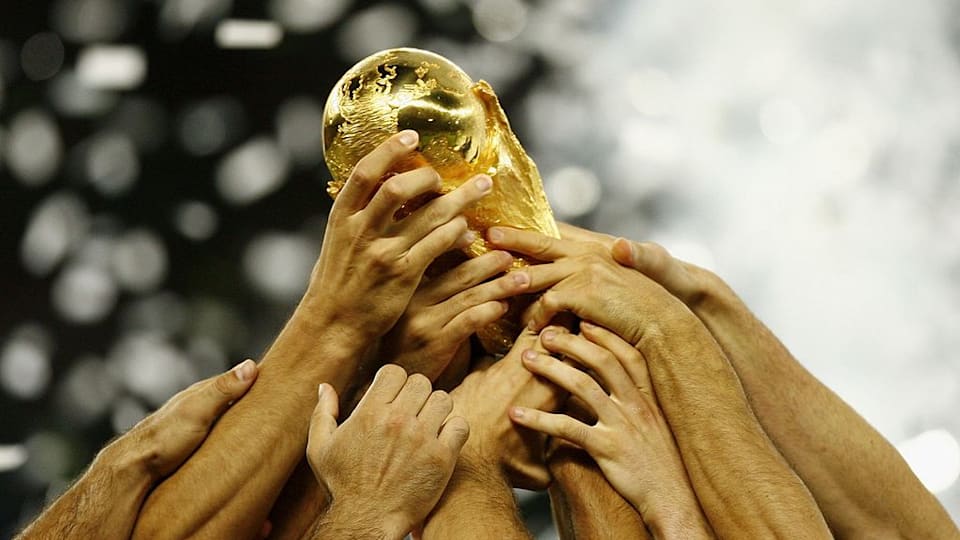
Awarded to the winners of World Cups held once every four years, the FIFA World Cup trophy is undoubtedly the most coveted title in world football.
The FIFA World Cup trophy, since its inception, has been the object of desire for every football-playing nation in the world, more than 200 of them currently, and their epic struggles on the field to win it has produced some memorable moments.
But being one of the most recognisable sporting symbols in the globe and consequently, the high value associated with it has also brought its fair share of unwanted attention to the iconic piece of silverware. This has made the FIFA World Cup trophy the centrepiece of some intriguing plots off the field as well.
FIFA World Cup trophy iterations
Over the years, there have been two different iterations or designs of the football World Cup trophy.
The Jules Rimet Trophy was the first iteration. It was used from 1930 to 1970. Brazil won it outright courtesy of becoming the first country in the history of the competition to become three-time champions (1958, 1962 and 1970).
A redesigned trophy, called the FIFA World Cup trophy, is the one used today and has been handed to the winners every four years, starting 1974.
Jules Rimet Trophy: 1930-1970
The journey of the FIFA World Cup trophy started with Jules Rimet, the third president of world football governing body FIFA. He laid down the plans for a football World Cup in 1928 and subsequently passed a vote the following year to hold the first edition in Uruguay in 1930.
The task of designing a trophy for the competition was commissioned to Abel Lafleur, a French sculptor who would later go on to compete in art competitions held during the Los Angeles 1932 Olympics.
Lafleur’s design featured a gold statuette of Nike, the Greek goddess of victory, holding up an octagonal Cup over her head. She had a garland around her neck.
It was inspired by the Nike of Samothrace statue, an incomplete yet iconic Greek statue from the Hellenistic era which is on display at Paris’ Louvre museum.
The trophy, originally dubbed Victory and commonly called the Coupe du Monde (French for World Cup), was 35cm in height and weighed 3.8kg. It was constructed with gold-plated sterling silver and it had a blue base made of semi-precious stone called lapis lazuli.
There were gold plates attached to each of the four sides of the base, on which the winning countries’ names were engraved after each edition.
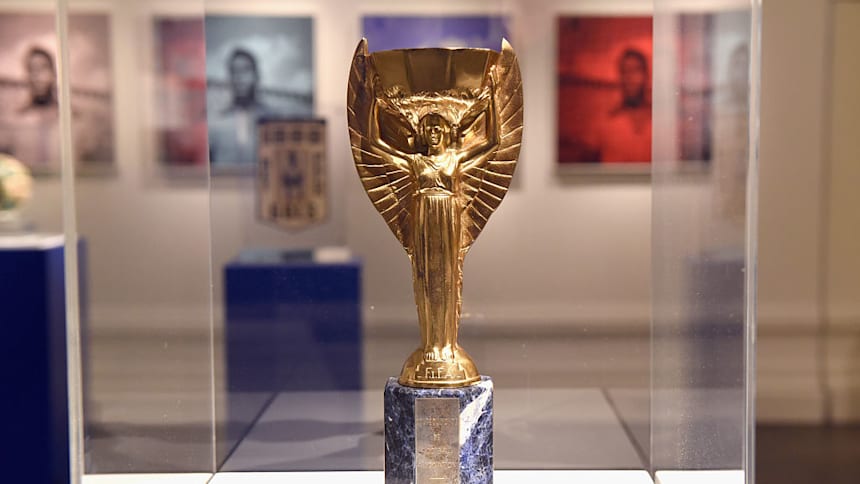
In 1946, it was renamed the Jules Rimet Trophy in honour of the erstwhile FIFA president’s 25th anniversary in office.
The trophy was taken to Uruguay aboard the Conte Verde, an Italian passenger ship which ferried Rimet, along with the national teams of France, Romania and Belgium to Montevideo for the maiden football World Cup.
Uruguay became the inaugural champions and kept the trophy in 1930 but Italy took it back to Europe in 1934 and kept it by defending their title in 1938.
Hidden in a shoebox
Concerns about the safety of the Jules Rimet Trophy during World War II led to an unlikely destination for the much coveted prize for the duration of the conflict.
Ottorino Barassi, an Italian who was serving as the FIFA vice-president at the time, quietly removed the trophy from the vault of a bank in Rome and hid it in a shoebox under his bed during the entirety of the War.
The trophy stayed safe under Barassi’s bed until the World Cup returned after WWII in 1950 in Brazil. Barassi, who was integral to Italy hosting the 1938 edition, also spearheaded the operations for hosting the 1950 edition.
In 1954, the old base of the Jules Rimet Trophy was replaced with a taller one to accommodate names of more winners.
Stolen in England
Though the Jules Rimet Trophy survived the World War unscathed, it nearly disappeared after being stolen ahead of the 1966 World Cup in England - the first time the tournament was being held at football’s spiritual home.
Four months before the World Cup was set to kick off, the Jules Rimet Trophy was on exhibition at the Methodist Central Hall in Westminster as part of the Sport with Stamps Stanley Gibbons Stampex rare stamp exhibition.
On March 20, 1966, the trophy disappeared from its display cabinet while a Sunday church service was being conducted in another part of the building. The thief reportedly never touched rare stamps, estimated to have been worth over three million Pounds at the time, and fled with just the trophy, which at the time was valued at 30,000 Pounds.
While the law enforcement agencies, including Scotland Yard, scrambled to recover the Jules Rimet Trophy, Joe Mears, the chairman of Football Association (FA) and London club Chelsea FC, received a ransom note from an individual claiming to be ‘Jackson’.
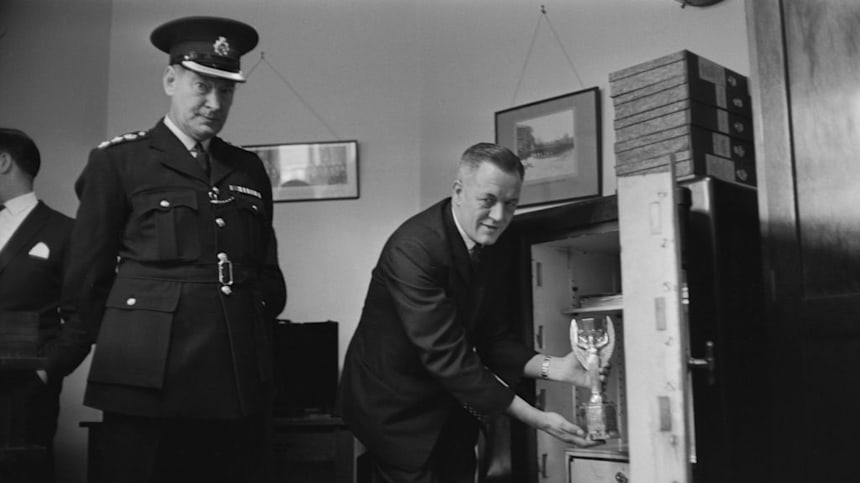
Jackson demanded 15,000 Pounds for the return of the trophy and included a removable lining from the top of the trophy as proof of possession. The handover was scheduled in front of Stamford Bridge, Chelsea’s home stadium.
What ensued seemed right out of a crime thriller.
After luring Jackson with fake money and scraps of paper, an undercover detective posing as Mears’ assistant tried to have him lead them to the stolen trophy. But Jackson realised something was wrong and tried to escape by jumping off a moving car.
Jackson was finally arrested after a dramatic pursuit and was revealed to be Edward Betchley, a petty thief with prior records. However, upon being interrogated Betchley claimed he didn’t steal the trophy and was only acting as a middleman for an elusive individual he referred to as ‘The Pole’.
Betchley was sentenced to two years of jail but the police could never track down ‘The Pole.’ The trophy, too, remained in the wind.
Pickles the dog to the rescue
While a nationwide hunt for the Jules Rimet Trophy continued, David Corbett, a Thames lighterman (barge operator), was out on a walk with his dog Pickles, a black and white collie, in the Beulah Hill district of southeast London. It was also a Sunday, exactly one week after the original theft.
As Corbett stopped at a telephone booth to make a phone call, the four-year-old canine sniffed out a package wrapped with newspapers and strings under one of Corbett’s neighbour's cars.
Corbett was initially sceptical and thought it might be a bomb but eventually succumbed to his curiosity and unwrapped the package.
“I picked it up and tore some paper and saw a woman holding a dish over her head, and disks with the words Germany, Uruguay, Brazil. I rushed inside to my wife. She was one of those anti-sport wives. But I said, ‘I've found the World Cup! I've found the World Cup!’” Corbett recalled his reaction to the Guardian years later.
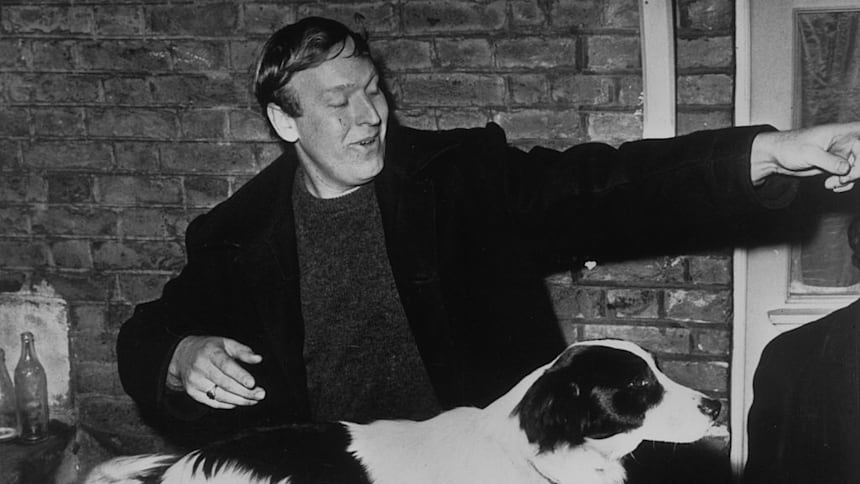
Corbett eventually went on to hand the trophy over to the local police station and was detained for a while on suspicion that he might have been involved in the theft. He, however, had an alibi and got the clean chit.
Both Corbett and Pickles, whom the bargeman had adopted from his brother as a pup because he ‘chewed on furniture a little too much’, became national heroes.
Pickles, who had gotten England out of a serious mess, went on to become a big celebrity and eventually a TV star.
Thanks to the duo, particularly Mr Pickles, England captain Bobby Moore got to hoist the original Jules Rimet Trophy at London’s Wembley Stadium as England won the World Cup on home soil after beating Germany in the final.
It remains the Three Lions’ only World Cup win to date and Queen Elizabeth II herself presented the trophy to Sir Bobby Moore.
Pickles, along with Corbett, were also invited to the England team’s celebration banquet after winning the trophy.
Brazil secure and lose the Jules Rimet Trophy
After Brazil won the World Cup for the third time in 1970, they were awarded the Jules Rimet Trophy permanently as it was stipulated that the first team to win the Cup thrice would get to keep the trophy perpetually.
The original trophy, however, was stolen for a second time in 1983 from the Brazilian Football Confederation (CBF) headquarters in Rio de Janeiro.
The original Jules Rimet Trophy was never recovered and it was claimed that it had been melted down into gold bars.
The CBF commissioned a replica trophy back in 1984 and the other replica, built by the FA after its first theft in 1966, was bought by FIFA in an auction in 1997. A British jeweller named George Bird had made a gilded bronze copy of the original trophy after being commissioned by the FA.
The only original piece of Abel Lafleur’s trophy in existence today is the original base, which was swapped out in 1954 for a taller one. The piece was discovered in 2015 stowed away in the basement of the FIFA headquarters in Zurich.
FIFA World Cup trophy: 1974-present
Since 1974, football world champions have been presented with the new version called the FIFA World Cup trophy.
Sculptors from seven countries sent in 53 submissions for the new design but eventually, it was commissioned to Italian artist Silvio Gazzaniga.
The FIFA World Cup trophy is 36.5 cm tall and is made of 6.175 kg of 18 karats (75%) gold. It has a circular base, 13 cm in diameter, made of two layers of malachite.
The design sees arching lines from the base spiral up and forms the base for a golden replica of the world. The trophy is hollow from the inside.
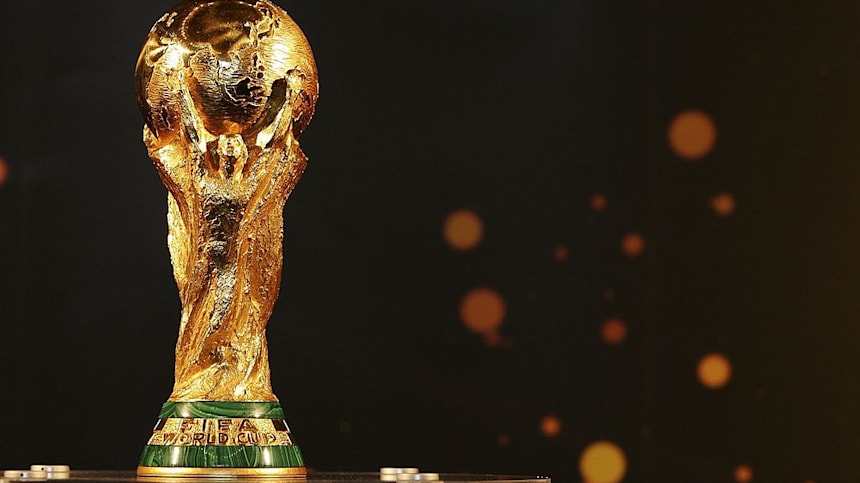
The trophy has the words FIFA World Cup engraved on its base. After the 1994 FIFA World Cup, a plate was added to the bottom of the trophy on which the names of winning countries are engraved in vertical order. After 2014, it was changed and names were rearranged in a spiral to accommodate more winners.
Unlike the Jules Rimet Trophy, the original FIFA World Cup trophy cannot be won outright anymore.
The new regulations state that it remains in FIFA's possession, secured at its Zurich headquarters, barring ceremonial requirements like the Trophy Tour and during the FIFA World Cup main draws and the final presentation.
Instead, the FIFA World Cup winners from each year get to permanently keep a gold-plated bronze replica, referred to as the FIFA World Cup Winners’ Trophy, for every tournament they win.
One such replica was also given to Nelson Mandela before South Africa hosted the FIFA World Cup in 2010. It was the only instance of an individual receiving an official replica of the trophy to date.
Additionally, only a select group of people, including heads of state and former World Cup winners, are allowed to touch the original FIFA World Cup trophy.


